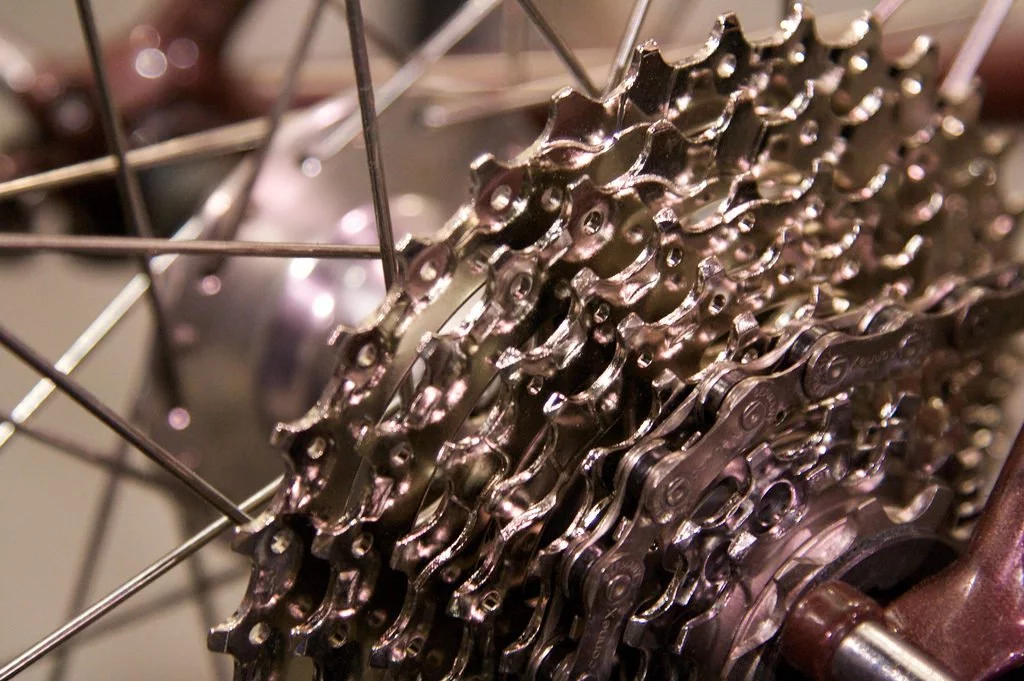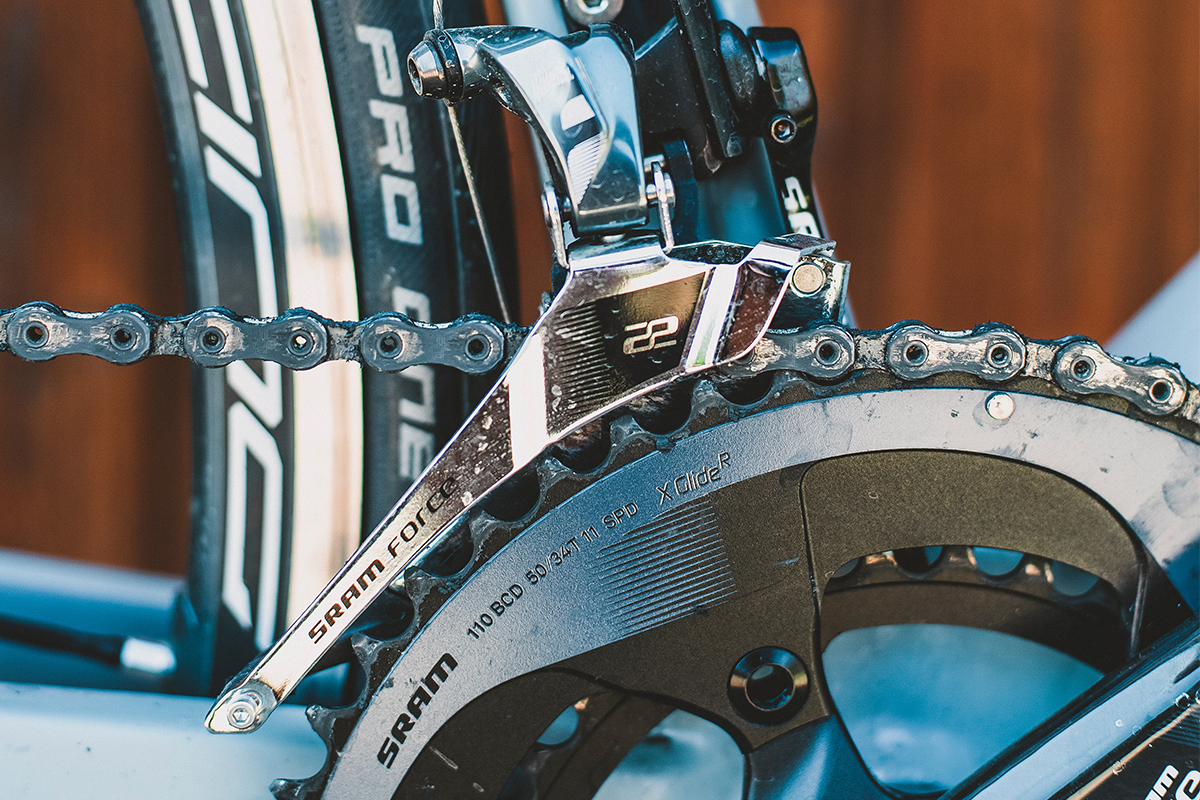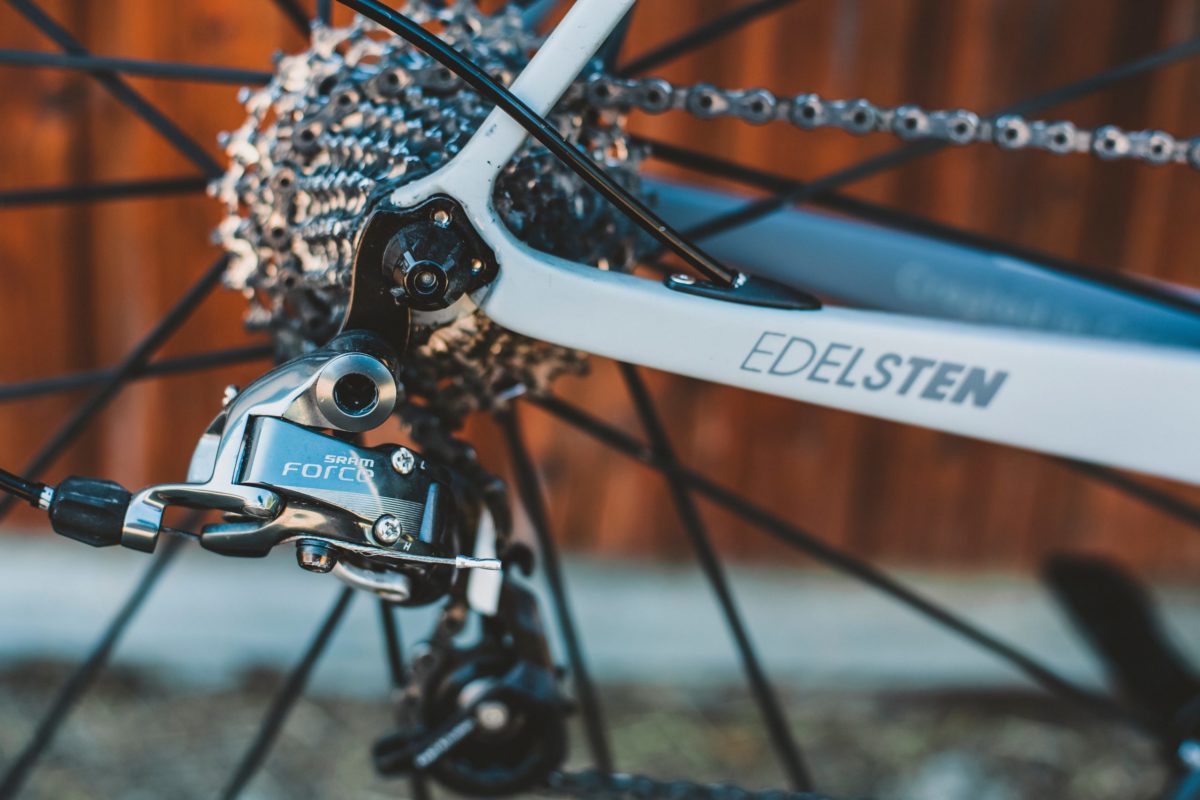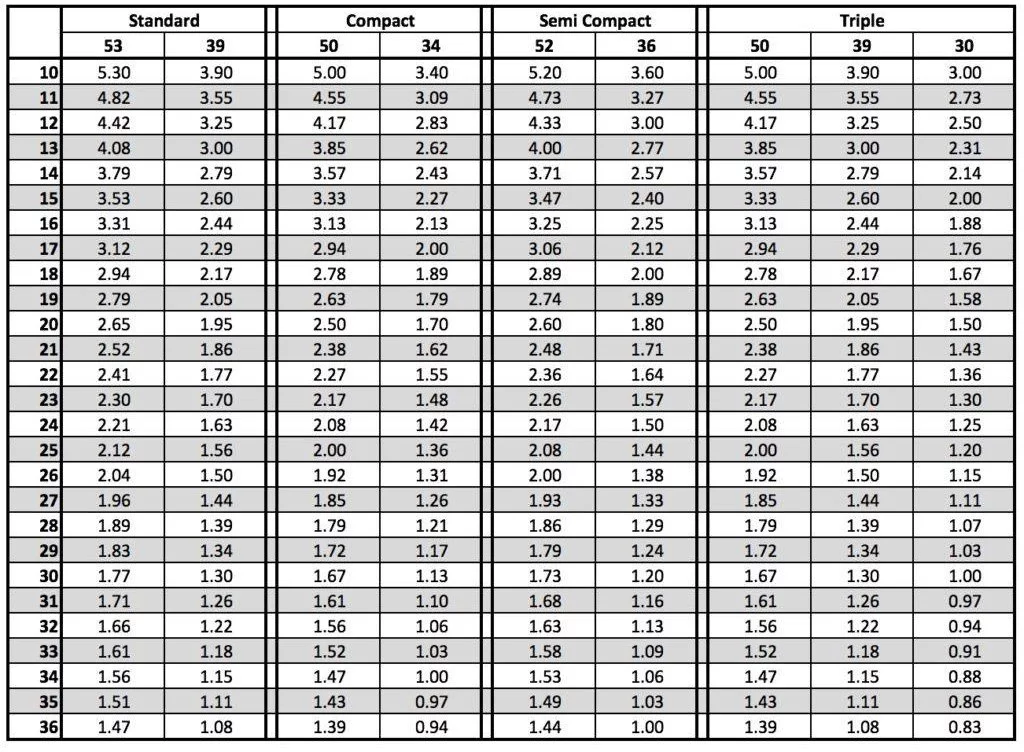If You Make the Back Gear Smaller, Is It Easier or Harder to Pedal? Explain. UPDATED
If You Make the Back Gear Smaller, Is It Easier or Harder to Pedal? Explain.
On the surface, understanding your bike gears is pretty simple. You push the lever 1 manner to make it easier to pedal, and the other to go faster. choosing the correct gears to install on your bike however, tin can be much trickier.
Most of us just terminate up riding the gears that came with our bikes, merely if you don't call up about swapping out for different scenarios, y'all might end upward making things much more hard than they need to exist.
The gear ratios y'all want to employ for a hilly cycling holiday in Mallorca are not the same every bit the gears y'all want for a time trial, criterium, club ride or city riding. Our consummate guide to bike gears takes the mystery out, and will have yous joining in with all the other bores banging on about ratios in no time at all.
Front end Gears (Chainrings/Crankset)
The front gears are referred to equally chainrings, or as a crankset, or by the less jargon-savvy cyclists, 'the front ones'. Actually, the whole associates with the crank arms and the front gears together is properly known as the 'crankset', or sometimes 'chainset'. Near cranksets have either two (called a double or 2x), or iii (chosen a triple or 3x) chainrings. Single (or 1x) chainrings are gaining popularity, particularly among mountain bikers and cyclocross riders, but are still a adequately niche application. On the crankset, the smallest chainring is closest to the frame. The smaller the chainring, the easier the pedalling. As we move the chain away from the centre line of the bike, the pedalling gets harder simply yous go faster. Typically the chainrings are identified past mentioning their position ("inner", "outer", or, in the case of a triple "middle"), or past their size "large band", "petty band". On a triple they're normally called "outer/large", "center" and the smallest i has a special name – "granny gear" or just "granny".

Rear Gears (Cassette)
The gears on the rear wheel are chosen 'cogs' and when you put a few of them together in ascending size and attach them onto your back wheel, they are referred to equally a 'cassette'. About bikes built in the last few years accept betwixt 8 and 11 cogs in the cassette. The largest cogs are closest to the wheel and the gears are numbered from the inside out. The larger the cog the 'lower' the gear and the easier it volition be to pedal, but the slower y'all will get.
How Many Gears?
When nosotros talk most how many "speeds" a wheel has, there tin can be some confusion. The marketing section likes to multiply the number of cogs past the number of chainrings because large numbers are impressive. But the fact is at that place's actually a lot of overlap, so a 9×2 doesn't really accept xviii gears. People who actually ride bikes but refer to the number of cogs in the cassette, so an 8 speed, a ix speed etc… They may too mention whether they accept a single, double, triple crankset, or they may simply say "ix×2" or "two×ix".
Derailleurs
'Derailleur' is pretty hard to pronounce, merely – fortunately – pretty easy to sympathize. The chain gets moved from one cog to another or one chainring to another by means of a derailleur. The front derailleur is a fairly simple device that simply pushes the chain off of ane chainring to exist picked upwardly or 'caught' by the next.
The rear derailleur is a little more complex as it has two jobs. Like the front, it guides the chain from i cog to the next, but information technology is also responsible for maintaining concatenation tension and taking up the slack when nosotros move from bigger gears to smaller ones. The rear derailleur has two petty gears (actually called 'pulleys') in information technology, and the chain makes an 'S' turn through them. The upper pulley (closest to the cassette) is referred to as the 'jockey pulley' and the lower pulley is chosen the 'idler caster'. The pulleys are held in position past the 'cage'.

You'll notice information technology'south much more difficult to shift your forepart gears while the chain is pulled really tight, so yous should lighten your stroke a bit when switching chainrings. The rear derailleur is much more than constructive at switching gears while pedalling hard. Information technology is important to note however, that in order to switch gears the chain must exist moving forward.
With both the front and the rear derailleur, when the shift cable is pulled, it will move the chain to a larger gear. When the cable is released, it will move the chain to a smaller gear. Just recall that larger gears at the rear mean easier pedalling but more torque, and larger gears at the front mean harder pedalling but more speed. Going from "easier" gears to "harder" gears is called "upshifting", and the opposite is called "downshifting".
Teeth & Cycle Gear Ratios Explained
xi cogs on the rear cassette and two on the front chainring essentially gives you 22 different options (though some of these may cantankerous over so not strictly true).
The fundamental chemical element that volition determine how hard you lot work is the deviation in the number of teeth (the wee pointy bits that claw through the gaps in your chain) between the front chainring at the front and your selected rear cog.
Let'due south accept my bike as an example:
The chainring (front) on my bike is 50/34T. That means the outer ring has 50 teeth and the inner ring has 34 teeth.
The rear cassette is 11 speed 11-32. This means there are 11 cogs ranging from 11 teeth up to 32 teeth (the exact cogs are 11/12/thirteen/xiv/xvi/eighteen/twenty/22/25/28/32).

The combination of your selected chainring and cog determine the gear ratio. The gear ratio, combined with the circumference of your wheel and tyre determines how far yous volition travel with each revolution of the cranks.
The Hardest Gear
Let's say I am in the hardest gear on each which ways I would be riding on the 50 tooth ring on the front, and the eleven molar ring on the back. To get our gear ratio we divide the number of teeth on the front end by the number on the back:
50 ÷ 11 = 4.55
This is expressed as four.55 : 1 pregnant that for every 1 turn I make of the pedals at the front end, I will turn the dorsum wheel 4.55 times. This is the gear I would use on the flat. It is going to take quite a lot of effort to go it moving, but when I do I will move speedily.
The Easiest Gear
This would be the reverse end, the small ring on the front end and the biggest on the back. The reason for this is that they are the closest together, meaning you get a really depression ratio. On the bike I ride this is 34 teeth at the front end and 32 at the back – so actually close.
34 ÷ 32 = 1.06
one.06 : one means I am but just moving the dorsum wheel through more than than 1 revolution for every plough of the crankset. This would be the gear I am using on the very toughest of climbs allowing mean to spin the wheels chop-chop to get my cadency high.
Different Gearing Ready-Ups

Crank Set up (Forepart Gears)
You may sometimes hear cranksets referred to as 'meaty' or 'standard'. A compact crankset typically has a 50 tooth (50T) big ring and a 34 tooth (34T) little-ring. Standard cranksets are typically 53T/39T. In near cases, you tin change your chainrings to accept different molar counts, but every bit a general rule you lot don't want to have more than a 16-tooth difference between the big ring and little ring or y'all may have shifting problems. As for triples, they tend to run fifty-fifty smaller gears and more closely spaced 26T/36T/46T and 52T/42T/32T are mutual triple crankset configurations. With 10 and eleven speed drivetrains becoming the norm, we're seeing triples fall out of fashion and even unmarried band cranksets are becoming pop because of the wide range of ratios an eleven-speed cassette can span.

Cassette (Rear Gears)
As mentioned earlier, today's bikes typically come with viii to 11 cogs in a cassette. When choosing cassettes, you can choose a cassette that has a narrow range of ratios simply closely spaced between each cog, or you could choose a cassette that offers a wide range of ratios but at the toll of bigger jumps between cogs. Choosing a bike that has more speeds reduces the tradeoff some, and gives you lot more versatility. If you do nigh of your riding in a place that is by and large apartment, information technology's probably all-time to opt for a narrow-range cassette with small-scale ratio jumps as that allows y'all to really fine-tune your cadence and effort level. If you live in an area that has more than varied terrain, a wider-ranged cassette may be the meliorate choice to assistance you lot get up those hills. Wider-ranged cassettes with higher cog counts typically accept the ratios more closely spaced on the smaller cogs, and and then have the bigger jumps in the bigger "climbing" cogs to give y'all a trivial of the best of both worlds.
What Can We Acquire From This?
The primal learning from all this information is to make a conscious selection when you purchase a cycle equally to the gear range that you want.
If you are climbing, and so the natural option is going to be a compact crankset, or in extreme cases a triple, only think about the rear cassette. My first bike had an 11-28, only I actually similar keeping a loftier cadency on the hills, so on my new bike I take opted for 11-32. This means I withal have a nice fast high gear, but the lowest gear is significantly easier to pedal. If y'all are a keen time trial passenger so you may want to opt for a standard crankset, equally it will give you a college top gear. This paired with something like an 11-23 rear cassette would be great for apartment grade as it would give you very pocket-sized changes between the gears meaning you could proceed the cadence exactly where y'all wanted it.
The cardinal is to know the kind of riding you lot are planning to practise with the bike you purchase and choose the gearing appropriately. I have produced the nautical chart below to help you understand the typical ratios available. Call back the college the ratio, the harder/quicker the gear is going to be.

How Practice We Use Gears?
So now you've had a quick intro to how your gears work together, hither are iii final tips to take with you on your next ride.
- Avoid 'cross-chaining': Cantankerous-chaining is when you lot have a niggling/niggling or big/big combination. This puts stress on the drivetrain and tin can cause premature wear of the components. Information technology'southward OK if you occasionally find yourself cross-chained – say for a curt, steep climb – but it is something y'all'll by and large desire to avoid. The rule of thumb to follow is that when on the big ring, only use the smaller two-thirds of the cassette. When on the inner (or eye) ring, only employ the inner two-thirds. When in 'granny gear' limit yourself to the largest ii or 3 cogs.
- Anticipate your shifts: Keep an eye on the road ahead and shift earlier y'all have to. You lot'll maintain a smoother power output, and you'll be shifting at a time when there's less stress on the drivetrain – so your shifts volition be smoother also. As you lot approach a reddish calorie-free or stop sign you should as well downshift a couple of gears, in anticipation of getting rolling once more as smoothly as possible.
- Keep pedalling!: It is much more efficient to go along a constant, steady power rather than 'burst and coast' riding. Information technology certain feels like you're getting better exercise when yous make that big endeavour, only you're putting all the load on your muscular organization, which isn't really practiced at sustained effort. Spinning calorie-free and fast ends up putting out the same corporeality of ability, but shifts the load to your cardio-vascular organisation, which is good at endurance activeness.
Additional Reading and Useful Links
RitzelRechner Gear Calculator
BikeCalc.com
CyclingTips.com – Understanding Gear Ratios and Why They Matter
Gear Ratio Basics
Yellow Jersey offer bike insurance to protect your equipment and travel insurance to cover medical mishaps while cycling overseas.
DOWNLOAD HERE
If You Make the Back Gear Smaller, Is It Easier or Harder to Pedal? Explain. UPDATED
Posted by: shannonsamay1943.blogspot.com


Comments
Post a Comment